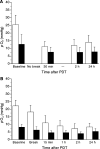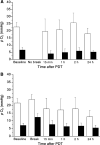Effects of light fractionation and different fluence rates on photodynamic therapy with 5-aminolaevulinic acid in vivo
- PMID: 12778078
- PMCID: PMC2741044
- DOI: 10.1038/sj.bjc.6600910
Effects of light fractionation and different fluence rates on photodynamic therapy with 5-aminolaevulinic acid in vivo
Abstract
To improve efficacy of photodynamic therapy (PDT) with intravenously administered 5-aminolaevulinic acid (ALA) fractionating the light dose or reducing the light intensity may be a possibility. Therefore, Syrian Golden hamsters were fitted with dorsal skinfold chambers containing an amelanotic melanoma (n=26). PDT was performed (100 mW cm(-2), 100 J cm(-2), continuously or fractionated, and 25 mW cm(-2), 100 J cm(-2); continuously or fractionated) using an incoherent light source following i.v. application of ALA. Following fractionated irradiation, the light was paused after 20 J cm(-2) for 15 min. Prior to and up to 24 h after PDT tissue, pO(2) was measured using luminescence lifetime imaging. The efficacy was evaluated by measuring the tumour volume of amelanotic melanoma cells grown subcutaneously in the back of Syrian Golden hamsters (n=36). Only high-dose PDT resulted in a significant decrease of pO(2). Irrespective of the mode of irradiation only high-dose PDT induced complete remission of all tumours (13 out of 13). It could be shown that low-dose PDT failed to induce a significant decrease of pO(2). No significant effect of fractionated irradiation was shown regarding the therapeutic efficacy 28 days after PDT. Thus performing a fractionated PDT with ALA or reducing the light intensity seems not to be successful in clinical PDT according to the present data.
Figures




Similar articles
-
Photodynamic therapy with 5-aminolaevulinic acid-induced porphyrins of an amelanotic melanoma in vivo.J Photochem Photobiol B. 1997 Aug;40(1):76-83. doi: 10.1016/s1011-1344(97)00027-4. J Photochem Photobiol B. 1997. PMID: 9301046
-
Photodynamic therapy with 5-aminolevulinic acid induces distinct microcirculatory effects following systemic or topical application.Photochem Photobiol Sci. 2006 May;5(5):452-8. doi: 10.1039/b514128a. Epub 2006 Mar 30. Photochem Photobiol Sci. 2006. PMID: 16685321
-
Fractionated illumination for oesophageal ALA-PDT: effect on blood flow and PpIX formation.Lasers Med Sci. 2001;16(1):16-25. doi: 10.1007/pl00011331. Lasers Med Sci. 2001. PMID: 11486333
-
Photodynamic therapy using 5-aminolaevulinic acid for experimental pancreatic cancer--prolonged animal survival.Br J Cancer. 1994 Aug;70(2):248-54. doi: 10.1038/bjc.1994.288. Br J Cancer. 1994. PMID: 8054272 Free PMC article.
-
Clinical uses of 5-aminolaevulinic acid in photodynamic treatment and photodetection of cancer: A review.Cancer Lett. 2020 Oct 10;490:165-173. doi: 10.1016/j.canlet.2020.06.008. Epub 2020 Jun 10. Cancer Lett. 2020. PMID: 32534172 Review.
Cited by
-
Mechanisms in photodynamic therapy: Part three-Photosensitizer pharmacokinetics, biodistribution, tumor localization and modes of tumor destruction.Photodiagnosis Photodyn Ther. 2005 Jun;2(2):91-106. doi: 10.1016/S1572-1000(05)00060-8. Epub 2005 Aug 10. Photodiagnosis Photodyn Ther. 2005. PMID: 25048669 Free PMC article.
-
Luminescent sensing and imaging of oxygen: fierce competition to the Clark electrode.Bioessays. 2015 Aug;37(8):921-8. doi: 10.1002/bies.201500002. Epub 2015 Jun 25. Bioessays. 2015. PMID: 26113255 Free PMC article. Review.
-
5-aminolevulinic acid photodynamic therapy versus argon plasma coagulation for ablation of Barrett's oesophagus: a randomised trial.Gut. 2004 Jun;53(6):785-90. doi: 10.1136/gut.2003.028860. Gut. 2004. PMID: 15138203 Free PMC article. Clinical Trial.
-
Review of photodynamic therapy in actinic keratosis and basal cell carcinoma.Ther Clin Risk Manag. 2008 Feb;4(1):1-9. Ther Clin Risk Manag. 2008. PMID: 18728698 Free PMC article.
-
Blood Flow Measurements Enable Optimization of Light Delivery for Personalized Photodynamic Therapy.Cancers (Basel). 2020 Jun 15;12(6):1584. doi: 10.3390/cancers12061584. Cancers (Basel). 2020. PMID: 32549354 Free PMC article.
References
-
- Abels C, Fritsch C, Bolsen K, Szeimies RM, Ruzicka T, Goerz G, Goetz AE (1997a) Photodynamic therapy with 5-aminolaevulinic acid-induced por-phyrins of an amelanotic melanoma in vivo. J Photochem Photobiol B 40: 76–83 - PubMed
-
- Abels C, Szeimies RM, Steinbach P, Richert C, Goetz AE (1997b) Targeting of the tumor microcirculation by photodynamic therapy with a synthetic porphycene. J Photochem Photobiol B 40: 305–312 - PubMed
-
- Ackermann G, Abels C, Baumler W, Langer S, Landthaler M, Lang EW, Szeimies RM (1998) Simulations on the selectivity of 5-aminolaevulinic acid-induced fluorescence in vivo. J Photochem Photobiol B 47: 121–128 - PubMed
-
- Blumenroder S, Augustin AJ, Koch FH (1997) The influence of intraocular pressure and systemic oxygen tension on the intravascular pO2 of the pig retina as measured with phosphorescence imaging. Surv Ophthalmol 42 (Suppl 1): S118–S126 - PubMed
MeSH terms
Substances
LinkOut - more resources
Full Text Sources

